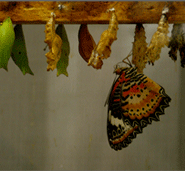It begins with a sharp presence weighing down on your skin. You feel it slowly penetrate the surface; it travels gently, then excruciatingly. The first sensation of movement inside your skin can instill in you a great resolve, a feeling of significance and purpose. It is a hollow feeling, this reclamation of your body from your own self. The needle stabs you continuously, vibrations crawling inside your skin, and pain moves on your flesh in slow, intoxicating circles. You make yourself believe that you are handing it over to yourself, and that it belongs to you, above all else. With every little turn the needle makes under your skin, with every little curve it inks on to you, there stands another mark to show you how you do not belong to your dreams, but to your defiance.
I know this because I have been through the process 6 times, for the five places on my body where ink has settled. Every time I go under the needle, I have the sinking feeling that the act is a masochistic one rather than one of self-expression: more wound than art. Every time, blood rises to the surface, and is quickly tamed.
It is when I look at Olivia’s photographs of the Ramnami tribe that this tension between my mind and my skin grows deeper and more etched. The ink itches, almost as if to break out from under coetaneous layers.
Olivia first started shooting the Ramnamis, a dalit tribe in Chhatisgarh, three years ago. Members of the tribe aren’t allowed inside temples because of the caste-system. In defiance of the archaic, oppressive system, the tribe decided to tattoo the name ‘Ram’ all over their faces and bodies: a voiceless declaration of faith and its reclamation. There is no sound to the Ramnamis’ rebellion, but it isn’t a quiet one. It’s written across their faces, in bold strides, lending them an alternate identity, fighting, as well as declaring, a history of caste-based discrimination.
The mutation of skin for the ramnamis is “likhita jaap”: simultaneous belief and defiance. It is an overwhelming declaration of self, a written identity, so to speak.
~
Ever since I was a child, words have been held hostage by my austerity, by my rage, my rebellion. I’ve filled my language with so much anger, that words, with me, forgot how to be beautiful, much like I did. I held onto every syllable, every sound with a vengeance, more so when there was not much else worth holding on to inside my head.
Words were my only truth. The only memories that I ever tried to keep from evaporating: an effort in futility of course. Every time I see the word “ram” etched in bold but precarious lines in a faded greenish-grey hue, my hand travels, unmindfully, to the inside of my thigh where I once carved the words ‘be’ and ‘see’. I must have been 11 or so, I have since learned to forgive myself for the sparse vocabulary.
I look, for the second time, at the old woman’s face in the second photograph and I can’t find a single point of focus. I see the word “ram” inscribed faintly, almost liquid before of my eyes, overpowering in its repetition. I close my eyes and touch my shoulder-blade where I have etched three lines from a Sylvia Plath poem called “Lady Lazarus”:
“Out of the ash
I rise with my red hair
and I eat men like air.”
There is no similarity between me and the woman in the picture. I’m a middle-class Delhi child of privilege and little faith, she’s a dalit woman from Chhattisgarh battling old systems and discrimination and asserting her right to the same faith that I reject. Her words seem to eclipse her physically, mine are incomplete without the body that hosts them. Except we’re both trying to hold on to words, trying to pin them down and make them manifest into something tangible.
Perhaps this is the thing about tattoos, the blood ‘other’: they allow you to own words. Words were always my only truth but I held them like one would hold sand - no matter how tight your grip is, the joy is only in the feeling of it slipping away, pouring out. I stare at ram upon wrinkles as I press ink into my skin.
Kalavati Kumari is a Delhi-based journalist.
Olivia Arthur was born in 1980 and is a Magnum photographer living in London.
Editor's Note.
Art that utilizes words as its 'paintbrush' is particularly intriguing: as opposed to an abstract stroke and a symbolic color, text is codified, sending great big brainwaves of pre-conceived associations. Its foundations lie in a system of signs and signifiers, with sounds and symbols that represent each word, syllable and letter.
Read MoreAlso in this issue
Illusion: Seeing Beyond Seeing
Meaning: In Search of Significance.
Melody: A Different Tune
Rhythm: Ordering Time









